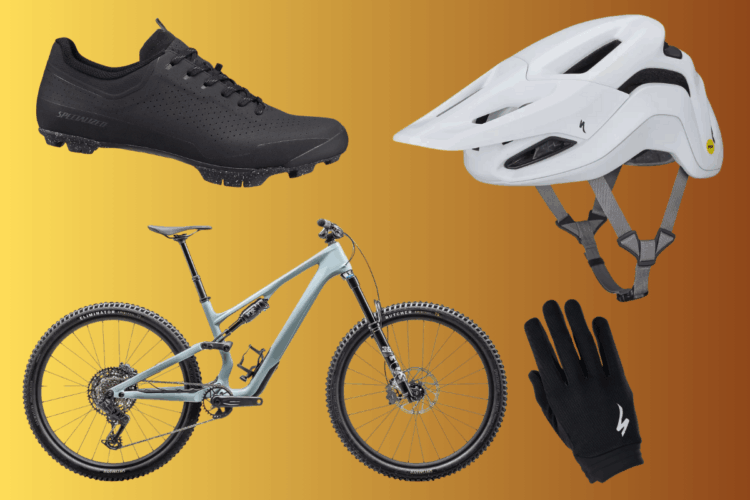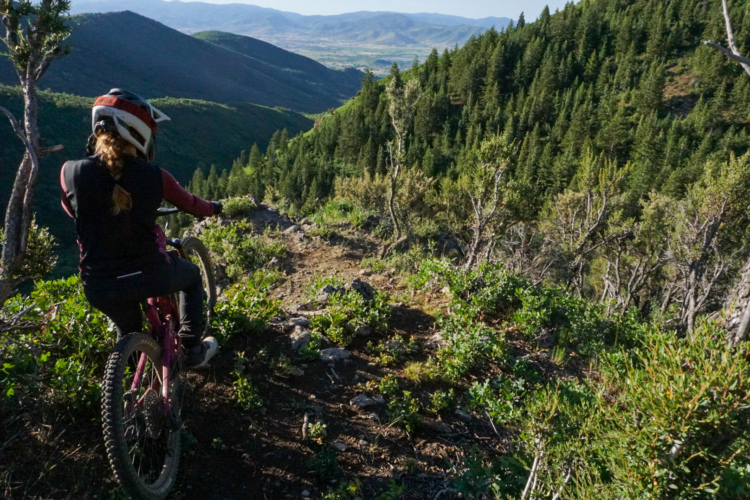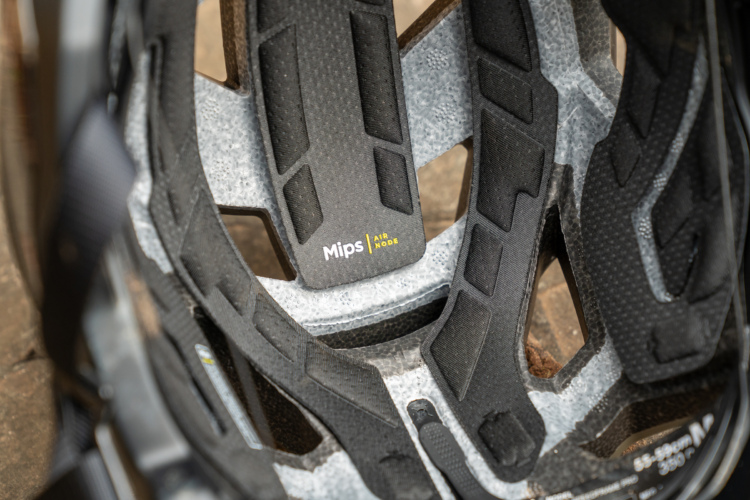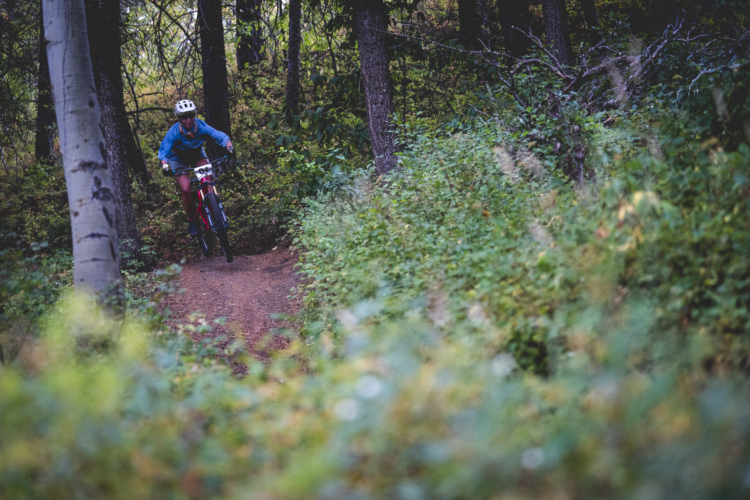Climbing
It only has 116mm of rear travel, so you kind of have to figure the 429 Trail is going to be a good climber–and it is. The Fox shock has three modes: open, medium, and firm. Each setting gives the bike a distinct feel, although I prefer to run shocks open whenever possible. The dw-link® suspension is already such an efficient climber, I rarely felt the need to use the firm setting.
What really impressed me about the 429 Trail is its technical climbing ability. The rear wheel stays glued to the ground and as long as you’ve got the legs, you can scoot up some chunky pitches. I’m sure the geometry helps in this regard as well. Since the bike isn’t overly long or slack, you don’t have to fight the front wheel while also trying to get up the hill.
Descending

This bike likes to get rowdy. In their description of the 429 Trail, Pivot claims that it feels like “…a 130mm bike when descending.“ I’m inclined to agree. You can push the bike hard and it can take it. The stout frame makes it easy to stay on a chosen line. After every ride the o-ring on the shock would be pushed all the way to the end, and on occasion I completely bottomed it out. This is a testament to how the bike begs to be thrashed–not a criticism. I prefer not to leave any travel on the table anyway, so it suited my riding style.

The other standout in the descending department was the Fox 34 fork. Holy shit that thing is nice! While I haven’t always been impressed with Fox’s forks over the past few years, their latest FIT4 damper is simply excellent. The fork on the Pivot rode high in its travel while cruising along, was supple over small stuff, and shrugged off big hits. What more could you ask of a trail fork?

The new Fox 34 is the real deal, and I would have no qualms recommending it on its own.
Component Report
Alright, I’m done gushing about the Fox fork, but what about the rest of the components?
This particular bike was spec’d with a Shimano 2×11 drivetrain, which is the first time in a long time that I’ve been on a mountain bike with multiple chainrings. And you know what? It totally didn’t suck.

I’m not too proud to admit that I used the granny gear at times, especially with the plus tires mounted. After all, this bikes comes in at 30+lbs with pedals. Front shifting was quick, reliable, and much easier on the thumb than I remembered. Maybe there’s something to these Side Swing front derailleurs after all…
The chainrings were 34/24, but I actually would have preferred a 36/26 crank. With a 42T on the cassette, there would still be a low enough gear for steep climbs, but you’d gain some top end speed.

The KS LEV Integra dropper was trouble-free throughout the test, only needing a couple spins of the barrel adjuster to keep the cable tensioned properly. One downside to running a 2x drivetrain, though, is there’s not an ideal place for the remote. When riding on unfamiliar terrain, there were occasions where I couldn’t get the post dropped in time.

I have had some hits and misses with Shimano’s latest XT brakes, but I had no issues with the set on this bike. They were strong, quiet, and the levers kept a consistent feel throughout the test.
Even though they aren’t a stock item, I would be remiss if I didn’t mention the Maxxis Tomahawk tires. The tread pattern ain’t pretty, but it works very well. Their short center knobs keep them rolling fast, but they also have massive cornering knobs. I’m not sure if Maxxis used a different formulation of their 3C Compound for these, but the rubber is downright gooey. Off camber? Pssh. Wet roots and rocks? Whatever. Off camber, wet, and roots? Meh. If you’re a fan of the Ardent, check these out–they’re what the Ardents want to be when they grow up.
However, the tradeoff for that sticky rubber is limited tread life, particularly on the center knobs.
Some Words on Wheel Size

I split my time on the 429 Trail between 29″ and 27.5+” wheels. In either configuration it’s a fun bike, and it’s great to have the option to run two distinctly different setups. While I had a blast on both sizes, if forced to pick just one, I’d go with the 29er for the following reasons:
- With pressures low enough (17-18 PSI) to take advantage of the plus-sized tire’s increased traction, there was a delay in the response of the shock. When pushing the bike in the corners, the tires would absorb the initial force, and then the shock would do its thing. This made for an unnerving sensation, particularly when linking up multiple turns. I could eliminate the problem by running 20 PSI, but then I was losing some of the traction benefits of the larger tires.
- There are no flip-chips or geometry adjustments when you put plus wheels on the Pivot. That means the bottom bracket drops by 1 cm when making the swap. But, that’s just the static measurement. When you factor in the sag of the larger tires, it gets much lower. The BB was a belly-dragging 28.5cm (11.25in) high when I was actually on the bike, so I found myself smacking the pedals frequently with the plus wheels. If your trails aren’t littered with roots and rocks, this may be less of a concern. Check out the chart below to compare measurements.
- In my experience, the plus tires were sketchy in the wet. Even the more aggressive Rekon+ mounted up front couldn’t handle slick rocks and roots. Anything remotely off-camber was downright terrifying in the rain. Dropping the tire pressure to low double digits helped some, but I never felt confident riding the plussers in the rain.
- My last reason again pertains to my particular trails, but hey, that’s where I rode the bike. On tight, technical trails, I just don’t think plus wheels are as much fun as the 29ers. They’re heavier, and you constantly fight that weight. When things open up, the weight isn’t as noticeable. And to be fair, this trait is something I have noticed on other plus bikes, not just the Pivot.
However, if I lived in the actual mountains, I would likely go with plus wheels. The plus wheels really shine when speeds increase. As I noted in my review of the Marin Pine Mountain 2, the large tires help mute smaller trail chatter, allowing you to look further down the trail and therefore, go faster. Just like my time on the Marin, I found myself setting new PRs on extended descents in North Georgia aboard the 429 Trail. These are trails I’ve ridden dozens of times on various bikes, so if it’s not the wheels helping me go faster, I don’t know what is.
End of the Ride

After spending a couple months on the Pivot 429 Trail, I found it to be a very easy bike to live with. It ticks all the right boxes in climbing, descending, and handling. One of its best traits, in my opinion, is that it’s fun to ride all the time. Some bikes shine on the descents, but can be a bear on the climbs. Other bikes climb like coked-up spider monkeys but are nervous when it’s time to come down. Not so with the Trail–it’s very balanced. On long rides or quick post-work rips, I always had a good time aboard the Pivot.
So, who’s it for? Well, it’s been pretty damned ideal for my kind of riding here in the Southeast–everything from the twisty and technical trails around metro Atlanta, to all-day rides in Ellijay, and backcountry epics in Pisgah. It’s an efficient pedaler and climber, with enough suspension to get rowdy on the descents, but not so much that it feels like bringing a gun to a knife fight. Coming from an XC/endurance background, I can safely classify it as a racer’s trail bike.
If that sounds like you, you owe it to yourself to take one out for a spin. Luckily, Pivot has an excellent demo program to allow you to do just that!












1 Comments
Jul 16, 2016